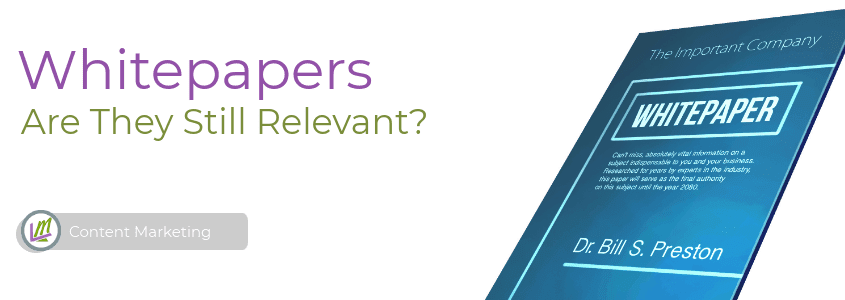What is a White Paper?
A white paper is an informational document made to promote or highlight the features of a product, service, or solution. Typically, a white paper is issued by a company and is usually written as sales and marketing documents.
Overall, a white paper’s main purpose is to be a marketing tool used to persuade potential customers to learn more about a business’ products or services and ultimately purchase their particular product or service.
A common misconception is that a white paper is meant to act as a user manual or other technical document that provides support to the user after making a purchase. When you see a white paper, know that it is meant to help bring a user to make a purchase, sign up for a service, or engage with a business in some other tangible way. Some white papers may also be more technical documents used to elaborate on an additional service or product offering.

Why is a White Paper an Important Lead Generation Tool?
A white paper is important because it is informative and plays a role in the marketing funnel. In fact, a white paper can be part of two steps of the marketing funnel: awareness and interest/consideration.
The information relayed in a white paper helps potential customers learn more about a product, service, or solution while also persuading them to take the next step and make a purchase. By bringing potential customers awareness about your product or service through a white paper, you’re already getting one of the more difficult parts of marketing out of the way.
When people don’t know about a product or service, it becomes very difficult for them to engage with it, let alone your business.
Building awareness is an integral part of any type of marketing, which is why they use of a white paper in addition to blog posts, social media posts and campaigns, and emails are necessary to get the word out. Without a white paper, chances are that you’re missing a major part of your marketing strategy.
Any good business would not want their customers to be underinformed, which is why you must take every opportunity to give them the information they need and desire to make a decision that benefits you and them. Having your potential customer as informed as they can possibly be will help pave the way for some serious interest, which should lead to true consideration.

How Do You Write a White Paper?
Most white papers are designed to promote a product, service, or technology for B2B (business to business) marketing strategies. B2B often means marketing between a manufacturer and a wholesaler or a wholesaler and a retailer.
In a B2B setting, a white paper is used to both inform and persuade the other company that a certain offering is better for solving a business problem or acknowledging a common business challenge.
When seen through the lens of B2B marketing, there are three types of white paper to be aware of:
-
- Backgrounders: these explain the technical features of a certain offering
- Numbered Lists: these highlight points or tips about an offering
- Problem/Solution: These point out a common business problem or challenge and offer an improved solution to it
Aside from the different types of white paper for B2B marketing, it is important to note that while a white paper is an important part of marketing, it does differ from other marketing materials. A white paper is not like a brochure or even a blog post.
Since a white paper is meant to offer persuasive and factual evidence about a particular offering or product, they are much more academic in nature than most other marketing materials. In fact, white papers are at least 2,5000 words in length and read more like a research paper or essay than a flashy blog post or a bit of web content.
With this in mind, writing a white paper of your own should look something like writing an academic paper or short essay in which an idea is introduced and elaborated on using supportive evidence and examples. In these examples, the tone should be informative while remaining stringently factual.
Opinions do not have much of a place in the typical white paper and should not be imposed on them. Rather, make sure that you remain matter-of-fact in your delivery of information while also providing evidence that your product, solution, or service can remedy a common problem in a totally new way.
Finally, make sure that your white paper is digging into relevant topics that your potential customers care about. Identify real problems that arise in today’s highly technological world and show how your company can fix them.
Relevant topics for digital marketing businesses can be anything from cloud technology and security solutions to software solutions for content creation and management and everything in between.

Let Directive Drive Your Content Marketing Strategy with White Papers
To help ensure that your white paper is successful, you want to have a website with landing pages, blog posts, and overall content that is informative, easy to navigate, and the answer to your potential customer’s questions.
At Directive, we know you deserve to have your website be the best it can be – and we can help. Get a free proposal from us today and learn how to make your business’ website one that not only ranks but converts.